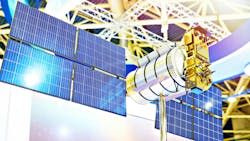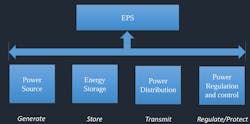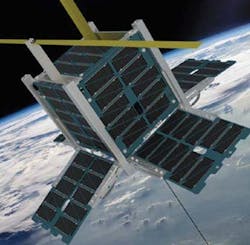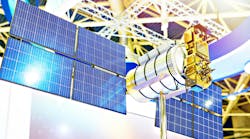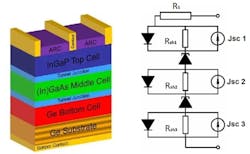Electrical Power Systems Meet the Density Demands of Small Satellites
Various power-generating system methods2 can be applied to space-based electrical power subsystems (EPS) to power spacecraft (Fig. 1).
Such power sources include:
- Solar arrays: Photovoltaic modules can absorb sunlight in space, which generates DC electric power for satellites
- Lithium-ion batteries: These batteries are rechargeable (secondary) batteries. They’re used as energy storage devices and are mostly connected to, and charged by, a prime energy source, delivering their energy to the load on demand. Secondary batteries are also used in applications to provide power remotely from a separate power source that they return to periodically for recharge.
- Radioisotopes: A radioisotope power system (RPS) can generate power by converting the heat released from the nuclear decay of radioactive isotopes, like Plutonium-238 (Pu-238), into electricity.
- Fuel cells: Fuel cells are used for power and energy storage. Fuel cells will support DC electrical power buses:
- Multiple reactant types and grades (for example O2/H2 or O2/CH4)
- Enable Commercial Lunar Payload Services (CLPS) landers to use CH4 propellant for power
There are a variety of spacecraft and satellites, and one compact type of satellite is the CubeSat (Fig. 2).
Power requirements for a CubeSat EPS2 are a bit different when it comes to:
- Power profile
- Power margin
- Bus voltage level
- Cycling/charging
- EPS component definition:
- Size of batteries
- Solar-array end-of-life (EOL) power
- Other various subsystem needs (peak and steady state)
CubeSat designers need to contend with thermal design, payloads, structures, and flight control (Fig. 3), and the EPS is integral to all of these.
Typical EPS System Requirements
EPS designers must provide continuous electrical power to spacecraft subsystems as necessary during a spacecraft mission life that will include eclipses and nighttime. The EPS must control and distribute all onboard power safely. In addition, the system has to provide enough power, including margin, for both peak and average power loads.
>>Download the PDF of this article, and check out the Library Series for similar articles and videos
Designers need to consider that downstream power converters are able to handle required loads. Bus isolation between downstream and upstream power loads must be provided. Likewise, the logic control system needs to know the EPS status and health, including voltage, temperature, current, and more.
Furthermore, the EPS system must protect itself and other subsystems from EMI, bus faults, transients, and load faults such as overvoltage, filtering, short circuits, and more.
Typically, a designer needs to determine the average power from the power equipment list (PEL) that includes the other electrical subsystems. There are also the mission requirements, such as duration, to consider. This may involve evaluation of the site for fixed space applications or orbital parameters.
Satellite Solar Array as an EPS Source
A satellite solar-cell array design must be done early on in the development of a satellite design mission. That’s because the size and deployment of the array has to be factored into the overall system design.
A high-performance satellite solar-cell array design will depend on the intensity of the incident sunlight available during the mission. The conversion efficiency of the array will also be a critical factor in determining the amount of available power.
Advances in solar array designs have led to increased efficiencies that exceed 30%. Multi-junction solar cells today provide the most efficient technology for generating electricity. Simplicity, high reliability, and relatively modest cost GaAs-based arrays are the reasons why they’re often selected to supply the electrical power system for most satellites (Fig. 4).
For example, the LISA-T is a very compact, stowable, thin-film solar array (Fig. 5). When fully deployed in space, it offers small spacecraft power generation and communication capability.
Summary
The EPS provides electrical power to all space vehicle loads and is crucial for completing defined missions in space. The most commonly employed architectures for CubeSats are battery-only or solar-array/battery configurations. Batteries must be treated as potential hazards since they combine stored energy with caustic materials.
Mechanical and thermal are the main subsystem interfaces within the EPS because designs are developed using an iterative process. Testing is also key: “Test what you fly and fly what you test.” Launch site handling is a major consideration, too.
References
1. Spacecraft Electrical Power Systems.
2. “GaN in Space,” Steve Taranovich, Power System Design, October 29, 2019.
3. “MSFC Electrical Power Systems for CubeSats,” ES30/Karen Cunningham, ES44/John Carr, ES44/Brandon Lewis, NASA, November 9, 2018.
4. “Electricity in space: How we get power beyond Earth,” Oleksandr Burlaka, Universe Space Tech, September 6, 2024.
5. “Design and Modeling of a useful Tool for Satellite Solar Array Preliminary Sizing and Power System Analysis,” Abdelkader HADJ DIDA, Department of Research and Space Instrumentation, Satellites Development Centre CDS Algerian Space Agency ASAL; Department of Electrical Engineering University of Sciences and Technology of Oran Mohamed Boudiaf USTO-MB, Oran, Algeria, IEEE 2019.
6. “Cubesats and Smallsats,” NASA JPL/California Institute of Technology.
7. “Guidelines on Lithium-ion Battery Use in Space Applications,” Barbara McKissock, Patricia Loyselle, and Elisa Vogel, Glenn Research Center, Cleveland, Ohio, NASA/TM-2009-215751 NESC-RP-08-75/06-069-I, May 2009.
8. “Introduction to NASA Applications using Fuel Cell and Electrolysis Technologies,” Ian Jakupca, NASA Glenn Research Center, December 3, 2021.
>>Download the PDF of this article, and check out the Library Series for similar articles and videos
About the Author

Steve Taranovich
Freelance Technical Writer, Phoenix Information Communication LLC
Steve is a contributing editor to Electronic Design.
Author of the non-fiction “Guardians of the Right Stuff,” a true story of the Apollo program as told by NASA and Grumman Corp. engineers, an astronaut, and technicians.
Experienced Editor-In-Chief of EETimes/Planet Analog and Senior Technical Editor at EDN running the Analog and Power Management Design Centers from 2012 to 2019.
A demonstrated history in electronic circuit design and applications for 40 years, and nine years of technical writing and editing in industry. Skilled in Analog Electronics, Space-related Electronics, Audio, RF & Communications, Power Management, Electrical Engineering, and Integrated Circuits (IC).
1972 to 1988 worked as a circuit design engineer in audio (8 years) and microwave (8 years). Then was Corporate Account Manager/applications engineer for Burr-Brown from 1988 to 2000 when TI purchased Burr-Brown. Worked for TI from 2000 to 2011.
Strong media and communication professional with a BEEE from NYU Engineering in 1972 and an MSEE from Polytechnic University in 1989. Senior Lifetime member of IEEE. Former IEEE Long Island, NY Director of Educational Activities. Eta Kappa Nu EE honor society member since 1970.
